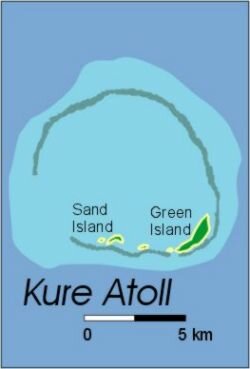Kure Atoll is the most remote of the Northwestern Hawaiian Islands, and the northern-most coral atoll in the world. Kure is an oval-shaped atoll, which is 10 km at its maximum diameter and 91 km west-northwest of Midway Atoll at the extreme northwest end of the Hawaiian archipelago. Green Island is the only permanent island in the atoll. The island is a nesting area for shearwaters, petrels, tropicbirds, boobies, frigatebirds, albatrosses, terns and noddies. It is also a wintering area for a variety of migratory bird species from North America and Asia.

Prior to 1827 Kure Atoll was visited by a half a dozen ships, and given a new name after each visit. Beginning in 1837, numerous ships have run aground on the reefs at Kure (previously known as Cure Island), and crews were stranded on the atoll for up to nine months at a time, eating monk seals, turtles and seabirds to survive.
On September 20, 1886, the ship Waialeale arrived at Kure and James Boyd took possession of the island in the name of King Kalškaua and the Hawaiian Kingdom. The ship's crew built a shack and left provisions and water tanks for shipwrecked sailors. In 1894 the island was leased for guano mining, but no mining was ever done. Kure Atoll was acquired by the United States of America as part of the Territory of Hawaii on July 7, 1898. In 1909, President Theodore Roosevelt made Kure part of the Hawaiian Islands Bird Reservation, reserving the atoll for the Department of Agriculture as a preserve for native birds.
Despite its northern location and relatively cool waters, the aquatic habitats of Kure house a diversity of corals and large invertebrates such as echinoderms, crustacea and mollusks. The turquoise waters of the lagoon and near-shore reefs support large schools of dolphins, jacks, sharks, goatfish, and chub, as well as morays, knifejaws, masked angelfish and rare native grouper. Recent aquatic surveys have identified rare fish species and behaviors seldom seen in the Main Hawaiian Islands, raising additional questions about the effects of human activities on marine ecosystems.
Kure Atoll is an important pupping and resting area for Hawaiian Monk seals. The Kure Atoll sub-population of monk seals apparently declined during the 1960s due to increased human disturbance from the Coast Guard station, but has been increasing in recent years. The monk seal population size at Kure is currently about 100-125 animals.
Other issues facing the atoll include threats from marine debris. The atoll lies in the path of a major Pacific current, resulting in tons of fishing nets and debris washing up on the reefs and beaches, which pose an entanglement hazard for monk seals, turtles, seabirds, fish and lobsters.
|

